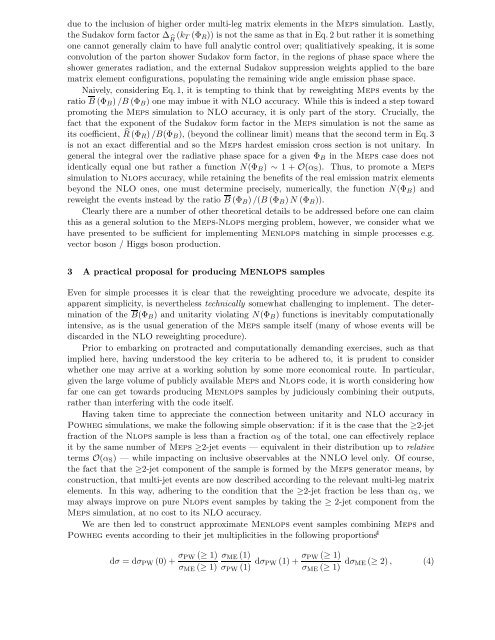2011 QCD and High Energy Interactions - Rencontres de Moriond ...
2011 QCD and High Energy Interactions - Rencontres de Moriond ...
2011 QCD and High Energy Interactions - Rencontres de Moriond ...
You also want an ePaper? Increase the reach of your titles
YUMPU automatically turns print PDFs into web optimized ePapers that Google loves.
due to the inclusion of higher or<strong>de</strong>r multi-leg matrix elements in the Meps simulation. Lastly,<br />
the Sudakov form factor ∆ R (kT (ΦR)) is not the same as that in Eq. 2 but rather it is something<br />
one cannot generally claim to have full analytic control over; qualitiatively speaking, it is some<br />
convolution of the parton shower Sudakov form factor, in the regions of phase space where the<br />
shower generates radiation, <strong>and</strong> the external Sudakov suppression weights applied to the bare<br />
matrix element configurations, populating the remaining wi<strong>de</strong> angle emission phase space.<br />
Naively, consi<strong>de</strong>ring Eq.1, it is tempting to think that by reweighting Meps events by the<br />
ratio B (ΦB) /B (ΦB) one may imbue it with NLO accuracy. While this is in<strong>de</strong>ed a step toward<br />
promoting the Meps simulation to NLO accuracy, it is only part of the story. Crucially, the<br />
fact that the exponent of the Sudakov form factor in the Meps simulation is not the same as<br />
its coefficient, R (ΦR)/B(ΦB), (beyond the collinear limit) means that the second term in Eq. 3<br />
is not an exact differential <strong>and</strong> so the Meps har<strong>de</strong>st emission cross section is not unitary. In<br />
general the integral over the radiative phase space for a given ΦB in the Meps case does not<br />
i<strong>de</strong>ntically equal one but rather a function N(ΦB) ∼ 1 + O(αS). Thus, to promote a Meps<br />
simulation to Nlops accuracy, while retaining the benefits of the real emission matrix elements<br />
beyond the NLO ones, one must <strong>de</strong>termine precisely, numerically, the function N(ΦB) <strong>and</strong><br />
reweight the events instead by the ratio B (ΦB)/(B (ΦB)N (ΦB)).<br />
Clearly there are a number of other theoretical <strong>de</strong>tails to be addressed before one can claim<br />
this as a general solution to the Meps-Nlops merging problem, however, we consi<strong>de</strong>r what we<br />
have presented to be sufficient for implementing Menlops matching in simple processes e.g.<br />
vector boson / Higgs boson production.<br />
3 A practical proposal for producing MENLOPS samples<br />
Even for simple processes it is clear that the reweighting procedure we advocate, <strong>de</strong>spite its<br />
apparent simplicity, is nevertheless technically somewhat challenging to implement. The <strong>de</strong>termination<br />
of the B(ΦB) <strong>and</strong> unitarity violating N(ΦB) functions is inevitably computationally<br />
intensive, as is the usual generation of the Meps sample itself (many of whose events will be<br />
discar<strong>de</strong>d in the NLO reweighting procedure).<br />
Prior to embarking on protracted <strong>and</strong> computationally <strong>de</strong>m<strong>and</strong>ing exercises, such as that<br />
implied here, having un<strong>de</strong>rstood the key criteria to be adhered to, it is pru<strong>de</strong>nt to consi<strong>de</strong>r<br />
whether one may arrive at a working solution by some more economical route. In particular,<br />
given the large volume of publicly available Meps <strong>and</strong> Nlops co<strong>de</strong>, it is worth consi<strong>de</strong>ring how<br />
far one can get towards producing Menlops samples by judiciously combining their outputs,<br />
rather than interfering with the co<strong>de</strong> itself.<br />
Having taken time to appreciate the connection between unitarity <strong>and</strong> NLO accuracy in<br />
Powheg simulations, we make the following simple observation: if it is the case that the ≥2-jet<br />
fraction of the Nlops sample is less than a fraction αS of the total, one can effectively replace<br />
it by the same number of Meps ≥2-jet events — equivalent in their distribution up to relative<br />
terms O(αS) — while impacting on inclusive observables at the NNLO level only. Of course,<br />
the fact that the ≥2-jet component of the sample is formed by the Meps generator means, by<br />
construction, that multi-jet events are now <strong>de</strong>scribed according to the relevant multi-leg matrix<br />
elements. In this way, adhering to the condition that the ≥2-jet fraction be less than αS, we<br />
may always improve on pure Nlops event samples by taking the ≥ 2-jet component from the<br />
Meps simulation, at no cost to its NLO accuracy.<br />
We are then led to construct approximate Menlops event samples combining Meps <strong>and</strong><br />
Powheg events according to their jet multiplicities in the following proportions 4<br />
dσ = dσPW (0) + σPW (≥ 1)<br />
σME (≥ 1)<br />
σME (1)<br />
σPW (1) dσPW (1) + σPW (≥ 1)<br />
σME (≥ 1) dσME (≥ 2) , (4)








![List of participants 27/2/09 [pdf] - Rencontres de Moriond - IN2P3](https://img.yumpu.com/17975746/1/190x135/list-of-participants-27-2-09-pdf-rencontres-de-moriond-in2p3.jpg?quality=85)







